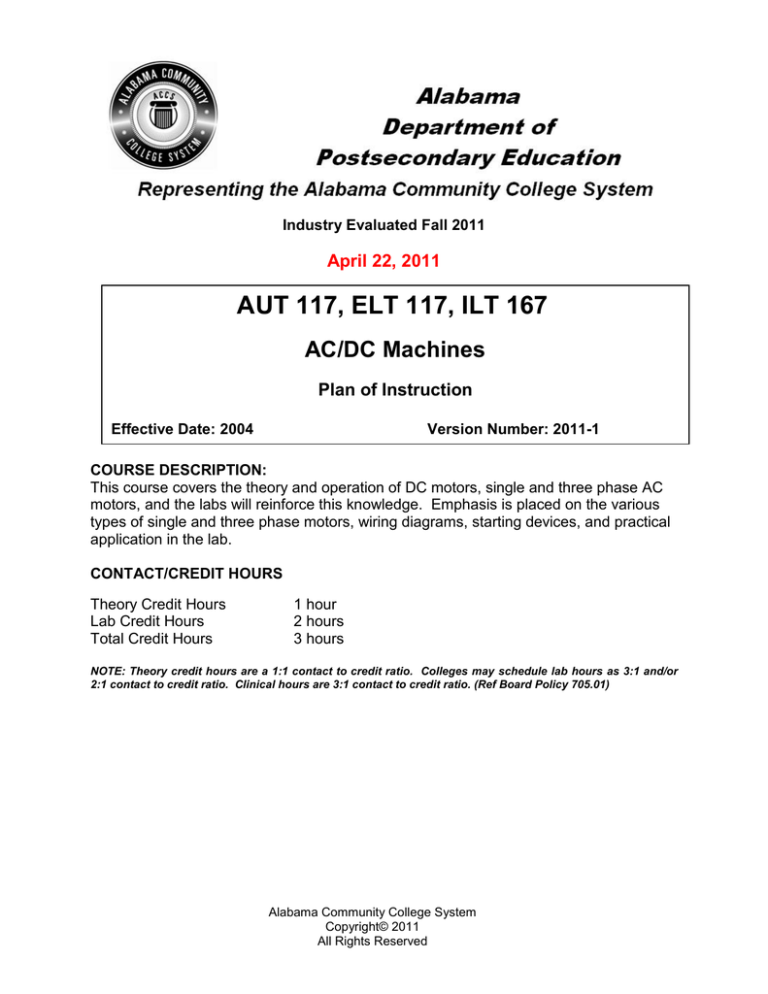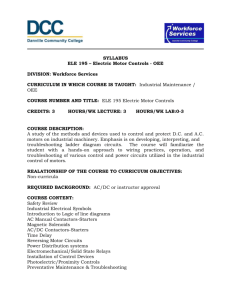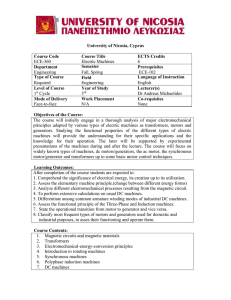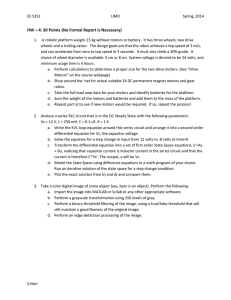
Industry Evaluated Fall 2011
April 22, 2011
AUT 117, ELT 117, ILT 167
AC/DC Machines
Plan of Instruction
Effective Date: 2004
Version Number: 2011-1
COURSE DESCRIPTION:
This course covers the theory and operation of DC motors, single and three phase AC
motors, and the labs will reinforce this knowledge. Emphasis is placed on the various
types of single and three phase motors, wiring diagrams, starting devices, and practical
application in the lab.
CONTACT/CREDIT HOURS
Theory Credit Hours
Lab Credit Hours
Total Credit Hours
1 hour
2 hours
3 hours
NOTE: Theory credit hours are a 1:1 contact to credit ratio. Colleges may schedule lab hours as 3:1 and/or
2:1 contact to credit ratio. Clinical hours are 3:1 contact to credit ratio. (Ref Board Policy 705.01)
Alabama Community College System
Copyright© 2011
All Rights Reserved
AC/DC Machines
AUT 117, ELT 117, & ILT 167
PREREQUISITE COURSES
As determined by college.
CO-REQUISITE COURSES
As determined by college.
PROFESSIONAL COMPETENCIES
• Comprehend the operation, connection, maintenance, and basic troubleshooting
of DC generators.
• Comprehend the operation, connection, maintenance, and basic troubleshooting
of DC motors.
• Comprehend the operation, connection, maintenance, and basic troubleshooting
of AC generators.
• Comprehend the operation, connection, maintenance, and basic troubleshooting
of single phase AC motors.
• Comprehend the operation, connection, maintenance, and basic troubleshooting
of three phase AC motors.
INSTRUCTIONAL GOALS
•
Cognitive – Comprehend principles and concepts related to AC/DC Machines.
•
Psychomotor – Apply principles of AC/DC Machines.
•
Affective – Value the importance of adhering to policy and procedures related to
AC/DC Machines.
STUDENT OBJECTIVES
Condition Statement: Unless otherwise indicated, evaluation of student’s attainment
of objectives is based on knowledge gained from this course. Specifications may be in
the form of, but not limited to, cognitive skills diagnostic instruments, manufacturer’s
specifications, technical orders, regulations, national and state codes, certification
agencies, locally developed lab/clinical assignments, or any combination of
specifications.
ACCS Copyright© 2011
All Rights Reserved
2
AC/DC Machines
AUT 117, ELT 117, & ILT 167
STUDENT LEARNING OUTCOMES
MODULE A – DC GENERATORS
MODULE DESCRIPTION – The purpose of this module is to teach the operation,
connection, maintenance, and basic troubleshooting of DC generators. Topics include DC
generator operating principles, construction, safety, schematics and output measurement.
PROFESSIONAL COMPETENCIES
A1.0 Comprehend the operation,
connection, maintenance, and
basic troubleshooting of DC
generators.
PERFORMANCE OBJECTIVES
A1.1 Connect a DC generator,
measure output and verify proper
operation.
LEARNING OBJECTIVES
A1.1.1
A1.1.2
A1.1.3
A1.1.4
A1.1.5
KSA
2
KSA
Explain how a DC generator works.
Explain the operating principles of a DC generator.
Describe the construction of a simple DC generator.
Identify the various hazards of working with DC generators.
Interpret schematics to identify system components and how they
connect.
A1.1.6 Describe how to connect a DC generator.
A1.1.7 Explain how to measure the output of a DC generator.
A1.1.8 Explain factors affecting DC generator voltage output.
A1.1.9 Explain left hand rule for generators.
A1.1.10 Describe how to determine generator output polarity.
A1.1.11 Explain basic principles of generator maintenance and troubleshooting.
A1.1.12 Interpret nameplate data for various generators.
MODULE A OUTLINE:
• DC Generators
o Operating principles
o Construction
o Connection
o Measuring the output
o Factors affecting voltage output
o Left hand Rule
o Polarity
o Maintenance and Troubleshooting
2
2
2
3
2
ACCS Copyright© 2011
All Rights Reserved
3
2
3
2
1
2
3
3
AC/DC Machines
AUT 117, ELT 117, & ILT 167
MODULE B – DC MOTORS
MODULE DESCRIPTION – The purpose of this module is to teach the operation,
connection, maintenance, and basic troubleshooting of DC motors. Topics include
operating principles, construction, safety, schematics, measuring and calculating various
inputs and outputs.
PROFESSIONAL COMPETENCIES
PERFORMANCE OBJECTIVES
KSA
B1.0 Comprehend the operation,
B1.1 Connect various DC motors, run,
2
connection, maintenance, and
reverse, vary the speed and verify
basic troubleshooting of DC
proper operation.
motors.
LEARNING OBJECTIVES
B1.1.1 Explain the operating principles of shunt, permanent magnet, series,
separately excited, and compound DC motors.
B1.1.2 Describe the construction of shunt, permanent magnet, series, separately
excited, and compound DC motors.
B1.1.3 Explain the right hand rule for DC motors.
B1.1.4 Identify the various hazards of working with DC motors.
B1.1.5 Interpret schematics to identify system components and how they
connect.
B1.1.6 Explain connections for shunt, permanent magnet, series, separately
excited, and compound DC motors.
B1.1.7 Describe how to reverse motor direction of shunt, permanent magnet,
series, separately excited, and compound DC motors.
B1.1.8 Describe how to vary the speed of shunt, permanent magnet, series,
separately excited, and compound DC motors.
B1.1.9 Measure output speed and torque, and calculate horsepower and power
factor.
B1.1.10 Measure input voltage and current, and calculate input power.
B1.1.11 Explain basic principles of DC motor maintenance and troubleshooting.
B1.1.12 Interpret nameplate data for various motors.
MODULE B OUTLINE:
• DC motors
o Types
Shunt
Permanent magnet
Series
Separately excited
Compound
o Operating principles
o Construction
o Connections
o Reversing
o Speed control
o Maintenance and Troubleshooting
ACCS Copyright© 2011
All Rights Reserved
KSA
2
2
1
3
2
2
2
2
3
3
3
3
4
AC/DC Machines
AUT 117, ELT 117, & ILT 167
MODULE C – AC GENERATORS
MODULE DESCRIPTION – The purpose of this module is to teach the operation,
connection, maintenance, and basic troubleshooting of AC generators. Topics include
operating principles, construction, safety, schematics, measuring and calculating various
inputs and outputs.
PROFESSIONAL COMPETENCIES
PERFORMANCE OBJECTIVES
KSA
C1.0 Comprehend the operation,
C1.1 Connect an AC generator,
2
connection, maintenance, and
measure output and verify proper
basic troubleshooting of AC
operation.
generators.
LEARNING OBJECTIVES
C1.1.1
C1.1.2
C1.1.3
C1.1.4
C1.1.5
Explain how an AC generator works.
Explain the operating principles of an AC generator.
Describe the construction of a simple AC generator.
Identify the various hazards of working with DC generators.
Interpret schematics to identify system components and how they
connect.
C1.1.6 Describe how to connect an AC generator for Wye and Delta operation.
C1.1.7 Explain how to measure the speed and output of an AC generator.
C1.1.8 Explain factors affecting AC generator voltage output.
C1.1.9 Explain left hand rule for AC generators.
C1.1.10 Explain basic principles of generator maintenance and troubleshooting.
D1.1.11 Interpret nameplate data for various generators.
KSA
2
2
2
3
2
2
3
3
1
3
3
MODULE C OUTLINE:
• AC Generators
o Operating principles
o Construction
o Connection
Wye operation
Delta operation
o Measuring output
o Factors affecting voltage output
o Left hand rule
o Maintenance and Troubleshooting
ACCS Copyright© 2011
All Rights Reserved
5
AC/DC Machines
AUT 117, ELT 117, & ILT 167
MODULE D – SINGLE PHASE AC MOTORS
MODULE DESCRIPTION – The purpose of this module is to teach the operation,
connection, maintenance, and basic troubleshooting of single phase AC motors. Topics
include operating principles, construction, safety, schematics, reversing direction, varying
speeds, measuring and calculating various inputs and outputs.
PROFESSIONAL COMPETENCIES
PERFORMANCE OBJECTIVES
KSA
D1.0 Comprehend the operation,
D1.1 Connect, run, reverse, and vary
2
connection, maintenance, and
the speed of various single phase
basic troubleshooting of single
AC motors and verify proper
phase AC motors.
operation.
LEARNING OBJECTIVES
D1.1.1 Explain the operating principles of capacitive, split phase, repulsion,
universal, and shaded pole AC motors.
D1.1.2 Describe the construction of capacitive, split phase, repulsion, universal,
and shaded pole AC motors.
D1.1.3 Identify the various hazards of working with AC Motors.
D1.1.4 Interpret schematics to identify system components and how they
connect.
D1.1.5 Explain connections for capacitive, split phase, repulsion, universal, and
shaded pole AC motors.
D1.1.6 Describe how to reverse motor direction for capacitive, split phase,
universal, and shaded pole AC motors.
D1.1.7 Describe how to vary the speed of single phase AC motors.
D1.1.8 Measure output speed and torque, and calculate horsepower and power
factor.
D1.1.9 Measure input voltage and current, and calculate input power.
D1.1.10 Calculate synchronous speed, frequency, and number of poles on AC
motors.
D1.1.11 Explain basic principles of single phase AC motor maintenance and
troubleshooting.
D1.1.12 Interpret nameplate data for various motors.
MODULE D OUTLINE:
• Single Phase AC motors
o Types
Capacitive
Split Phase
Repulsion
Universal
Shaded Pole
o Construction
o Connections
o Reversing
o Speed control
o Maintenance and Troubleshooting
ACCS Copyright© 2011
All Rights Reserved
KSA
2
2
3
2
2
2
2
3
3
3
3
3
6
AC/DC Machines
AUT 117, ELT 117, & ILT 167
MODULE E – THREE PHASE AC MOTORS
MODULE DESCRIPTION – The purpose of this module is to teach the operation,
connection, maintenance, and basic troubleshooting of three phase AC motors. Topics
include operating principles, construction, safety, schematics, reversing direction, varying
speeds, measuring and calculating various inputs and outputs.
PROFESSIONAL COMPETENCIES
PERFORMANCE OBJECTIVES
KSA
E1.0 Comprehend the operation,
E1.1 Connect, run, reverse, and vary
2
connection, maintenance, and
the speed of various three phase
basic troubleshooting of three
AC motors and verify proper
phase AC motors.
operation.
LEARNING OBJECTIVES
E1.1.1
E1.1.2
E1.1.3
E1.1.4
KSA
Explain the operating principles of Wye and Delta AC motors.
Describe the construction of Wye and Delta AC motors.
Identify the various hazards of working with AC generators.
Interpret schematics to identify system components and how they
connect.
E1.1.5 Explain connections for three-lead, six-lead, nine-lead, and 12-lead three
phase AC motors.
E1.1.6 Describe how to reverse motor direction for three phase AC motors.
E1.1.7 Describe how to vary the speed of three phase AC motors.
E1.1.8 Measure output speed and torque, and calculate horsepower and power
factor.
E1.1.9 Measure input voltage and current, and calculate input power.
D1.1.10 Calculate synchronous speed, frequency, and number of poles on AC
motors.
E1.1.11 Explain basic principles of three phase AC motor maintenance and
troubleshooting.
E1.1.12 Interpret nameplate data for various motors.
MODULE E OUTLINE:
• Three phase AC motors
o Types
Wye
Delta
o Operating principles
o Construction
o Connections
Three-lead
Six-lead
Nine-lead
12-lead
o Reversing
o Speed control
o Maintenance and Troubleshooting
2
2
3
2
ACCS Copyright© 2011
All Rights Reserved
7
3
2
2
3
3
3
3
3
AC/DC Machines
AUT 117, ELT 117, & ILT 167
LEARNING OUTCOMES TABLE OF SPECIFICATIONS
The table below identifies the percentage of learning objectives for each module.
Instructors should develop sufficient numbers of test items at the appropriate
level of evaluation.
Limited
Knowledge and
Proficiency
KSA
Module A
Module B
Module C
Module D
Module E
ACCS Copyright© 2011
All Rights Reserved
1
8%
8%
9%
Moderate
Knowledge
and
Proficiency
2
58%
50%
45.5%
50%
42%
Advanced
Knowledge
and
Proficiency
3
34%
42%
45.5%
50%
58%
Superior
Knowledge
and
Proficiency
4
8
AC/DC Machines
Indicator
1
2
3
4
AUT 117, ELT 117, & ILT 167
Learner’s Knowledge, Skills and Abilities
Key Terms
Description
• Identifies basic facts and terms about the subject or
competency.
Limited
Knowledge • Performs simple tasks associated with the
and
competency. Needs to be told or shown how to do
Proficiency
most tasks.
• Requires close supervision.
• Identifies relationship of basic facts and states
general principles and can determine step-by-step
Moderate
procedures for doing the competency.
Knowledge
and
• Performs most parts of the competency. Needs help
Proficiency
only on hardest parts.
• Requires limited supervision.
• Analyzes facts and principles and draws conclusions
about the subject to include why and when the
Advanced
competency must be done and why each step is
Knowledge
needed. Can predict outcomes.
and
• Performs all parts of the competency. Needs only a
Proficiency
spot check of completed work.
• Requires little or no direct supervision.
• Can evaluate conditions and make appropriate
Superior
decisions as related to resolving problems.
Knowledge
• Performs competency quickly and accurately with no
and
direct supervision and is able to instruct and
Proficiency
supervise others.
ACCS Copyright© 2011
All Rights Reserved
9




